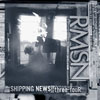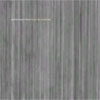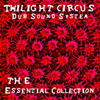 While my first exposure to Takemura's music was through the Child'sView material licensed in the US by Bubblecore, it wasn't until I heardhis album Scopeon Thrill Jockey that his music made a thunderous impact. Influencesfrom both Japanese traditionals and modern electronics collided with adelicate and refined attention to composition, structure and sound.Seeing Takemura live with vocalist Aki Tsuyuko on that tour drove theentire experience home for me. With the following Sign 12" and Hoshi No Koealbum, Takemura expanded on the sound, and let the music developbrilliantly, with songs that comfortably ran a full course without evergetting dull or mundane. However, his latest full-length album is adisappointment. Rather than a solid collection of 10 or so tracks, thealbum is saturated with 16 incomplete sounding compositions, stretchedto 78 minutes, nearly all exploiting the pesky Apple Macintosh voiceimitation program which (despite being a few years out of style) isirritating. The musical direction this time around leans towards moreEuropean trends, staying close to a rigid 4/4 beat and languid sounds,not entirely unlike the music coming from Morr or Bip Hop compilations.Sadly, most of the time the music sounds like it's intentionally takinga backseat to computerized vocals, which are painful by the thirdtrack, "Wandering," and downright unbearable by the seventh track, the9+ minute "Lost Treasure (4th version)." Even when Takemura drops thevoice and breaks free from the confines of 4/4 rhtyhm, the results aremediocre. Songs like "Mumble," which sound like an array of randomtones would be nice if something actually happened in its 5+ minuteother than an addition of percussion, wheras "Polymorphism," whilepleasant, could easily be new wave elevator music. Takemura's atalented composer and producer, but I'll be eagerly awaiting a 12"single remix or something to help me get past this album.
While my first exposure to Takemura's music was through the Child'sView material licensed in the US by Bubblecore, it wasn't until I heardhis album Scopeon Thrill Jockey that his music made a thunderous impact. Influencesfrom both Japanese traditionals and modern electronics collided with adelicate and refined attention to composition, structure and sound.Seeing Takemura live with vocalist Aki Tsuyuko on that tour drove theentire experience home for me. With the following Sign 12" and Hoshi No Koealbum, Takemura expanded on the sound, and let the music developbrilliantly, with songs that comfortably ran a full course without evergetting dull or mundane. However, his latest full-length album is adisappointment. Rather than a solid collection of 10 or so tracks, thealbum is saturated with 16 incomplete sounding compositions, stretchedto 78 minutes, nearly all exploiting the pesky Apple Macintosh voiceimitation program which (despite being a few years out of style) isirritating. The musical direction this time around leans towards moreEuropean trends, staying close to a rigid 4/4 beat and languid sounds,not entirely unlike the music coming from Morr or Bip Hop compilations.Sadly, most of the time the music sounds like it's intentionally takinga backseat to computerized vocals, which are painful by the thirdtrack, "Wandering," and downright unbearable by the seventh track, the9+ minute "Lost Treasure (4th version)." Even when Takemura drops thevoice and breaks free from the confines of 4/4 rhtyhm, the results aremediocre. Songs like "Mumble," which sound like an array of randomtones would be nice if something actually happened in its 5+ minuteother than an addition of percussion, wheras "Polymorphism," whilepleasant, could easily be new wave elevator music. Takemura's atalented composer and producer, but I'll be eagerly awaiting a 12"single remix or something to help me get past this album.
Look up Music for gazing upwards brought to you by Meat Beat Manifesto & scott crow, +/-, Aurora Borealis, The Veldt, Not Waving & Romance, W.A.T., The Handover, Abul Mogard & Rafael Anton Irisarri, Mulatu Astatke, Paul St. Hilaire & René Löwe, Songs: Ohia, and Shellac. Aurora Borealis image from California by Steve. Get involved: subscribe, review, rate, share with your friends, send images! |



 The first song on the new Anomonoan album is called "Sixteen Ways," butI need only two words to sum it up: Grateful Dead. The promo materialhinted that this album was inspired by the birth of Ned Oldham's sonand daughter, which is a fine and noble reason to record an album, butI would question the wisdom of including a field recording of a baby'scrying (Sam Oldham, who must be one of the newborn Oldham clan)overdubbed and softly accenting the lyrics on "Sixteen Ways," which atthis point declaim the crying of a baby as reassurance that the baby isalive. That said, this is probably my best song on "Asleep Many Yearsin the Wood." The rock songs on this album have an undeniablecountry/classic rock slant and I have a hard time listening to musicthat reminds me of The Eagles or something worse. Looking through theinserts, I noticed on the back a photo of a bottle of whiskey perchedon a window sill, with the label altered to read the band name andalbum title. This is a Photoshop sleight-of-hand which I most recentlysaw featured on the cover of Motley Crue's autobiography "The Dirt,"except there it was appropriately a bottle of Jack Daniels (here, itlooks more like what once was a bottle of Old Smuggler). Despite theshared aesthetic, I could not find any songs on the Anonomoan albumwhich recalled either early or later Motley Crue, although I might beable to make a case for "Time for Change," (circa Dr. Feelgood)sounding like "Y'Know" if I tried hard enough. The most heartwarmingparts of Anomonoan songs occur in the slower songs when Ned's voiceswoops up a few octaves and teeters on the edge of high notes he canbarely hold onto. Oldham manages to cling, however tenuous the grip,and the warble and the persistence are a beautiful thing in his voice.It is different from brother Will's, but Ned's clearly evidences theOldham vocal genome. Appropriately, one of these swoops occurs in"Bluebird of Happiness" when the lyrics croon, "and there's a contrarybreeze a-blowin'." Whether the headwind is the cause or theinterpretation of Oldham's vocal wisps, he is wise to let them take thesongs where they do, for they have the power to punctuate and decoratewhat might otherwise become bland country rock songs.
The first song on the new Anomonoan album is called "Sixteen Ways," butI need only two words to sum it up: Grateful Dead. The promo materialhinted that this album was inspired by the birth of Ned Oldham's sonand daughter, which is a fine and noble reason to record an album, butI would question the wisdom of including a field recording of a baby'scrying (Sam Oldham, who must be one of the newborn Oldham clan)overdubbed and softly accenting the lyrics on "Sixteen Ways," which atthis point declaim the crying of a baby as reassurance that the baby isalive. That said, this is probably my best song on "Asleep Many Yearsin the Wood." The rock songs on this album have an undeniablecountry/classic rock slant and I have a hard time listening to musicthat reminds me of The Eagles or something worse. Looking through theinserts, I noticed on the back a photo of a bottle of whiskey perchedon a window sill, with the label altered to read the band name andalbum title. This is a Photoshop sleight-of-hand which I most recentlysaw featured on the cover of Motley Crue's autobiography "The Dirt,"except there it was appropriately a bottle of Jack Daniels (here, itlooks more like what once was a bottle of Old Smuggler). Despite theshared aesthetic, I could not find any songs on the Anonomoan albumwhich recalled either early or later Motley Crue, although I might beable to make a case for "Time for Change," (circa Dr. Feelgood)sounding like "Y'Know" if I tried hard enough. The most heartwarmingparts of Anomonoan songs occur in the slower songs when Ned's voiceswoops up a few octaves and teeters on the edge of high notes he canbarely hold onto. Oldham manages to cling, however tenuous the grip,and the warble and the persistence are a beautiful thing in his voice.It is different from brother Will's, but Ned's clearly evidences theOldham vocal genome. Appropriately, one of these swoops occurs in"Bluebird of Happiness" when the lyrics croon, "and there's a contrarybreeze a-blowin'." Whether the headwind is the cause or theinterpretation of Oldham's vocal wisps, he is wise to let them take thesongs where they do, for they have the power to punctuate and decoratewhat might otherwise become bland country rock songs. In addition to being an acoustic guitar virtuoso, SteffenBasho-Junghans also delights in painting, particularly landscapes. Thisaspect of his creative life sheds light on his latest album, a soloacoustic trip though wide-open country scenes inspired by his ruralupbringing. Basho-Junghans (he adopted the surname of guitarist RobbieBasho in his thirties as an homage to his idol) approaches the projectmuch like a painting, and the guitar serves as his brush, craftingswirls and flourishes of sounds that fall back in on themselves andreemerge repeatedly. Each of the six tracks serves as a movement, asimple element in a broader scene. The twenty-minute six-string opener,"The River Suite," begins with a light ascension of plucked notes,lifting the music up and across the rapid cascade of tones that beginto rush beneath it. The music follows the stream, building, releasing,pausing, lingering, and all developing over a repeated body ofplucking. The repetition can be somewhat tiring, especially on thelonger tracks, like "The Takoma Bridge Incident." Though the ideas arecompelling in parts, they are exhausted by the end of the piece. Theshorter excursions on the second half of the album seem to discover andconvey their concepts much more effectively. "Rainbow Dancing" finds aclear melody, and stands as one of the more pleasant songs. On thistrack, Basho-Junghans switches to a twelve-string guitar, giving thetrack a lush, full-bodied sound that feeds the pastoral theme of thealbum. It sounds like how lying in a patch of sun soaked grass feels.Another advantage that "Rainbow Dancing" has is that it doesn't lingeron so long that you grow tired of its ideas. The lonely melody of"Autumn II" is perfectly evocative of the wailing voice of a bluegrassfolk spiritual. The weariness expressed by the piece gives off splashesof rust red and fading green, leading into the dusky "Epilogue." Thoughthe span of the album may be marked with lulls, the higher points of Rivers and Bridgesshine through. Basho-Junghans has produced a musical landscapepainting, complete with the valleys and crests, shadows andilluminations; the subtle nuances that make a work worth seeing.
In addition to being an acoustic guitar virtuoso, SteffenBasho-Junghans also delights in painting, particularly landscapes. Thisaspect of his creative life sheds light on his latest album, a soloacoustic trip though wide-open country scenes inspired by his ruralupbringing. Basho-Junghans (he adopted the surname of guitarist RobbieBasho in his thirties as an homage to his idol) approaches the projectmuch like a painting, and the guitar serves as his brush, craftingswirls and flourishes of sounds that fall back in on themselves andreemerge repeatedly. Each of the six tracks serves as a movement, asimple element in a broader scene. The twenty-minute six-string opener,"The River Suite," begins with a light ascension of plucked notes,lifting the music up and across the rapid cascade of tones that beginto rush beneath it. The music follows the stream, building, releasing,pausing, lingering, and all developing over a repeated body ofplucking. The repetition can be somewhat tiring, especially on thelonger tracks, like "The Takoma Bridge Incident." Though the ideas arecompelling in parts, they are exhausted by the end of the piece. Theshorter excursions on the second half of the album seem to discover andconvey their concepts much more effectively. "Rainbow Dancing" finds aclear melody, and stands as one of the more pleasant songs. On thistrack, Basho-Junghans switches to a twelve-string guitar, giving thetrack a lush, full-bodied sound that feeds the pastoral theme of thealbum. It sounds like how lying in a patch of sun soaked grass feels.Another advantage that "Rainbow Dancing" has is that it doesn't lingeron so long that you grow tired of its ideas. The lonely melody of"Autumn II" is perfectly evocative of the wailing voice of a bluegrassfolk spiritual. The weariness expressed by the piece gives off splashesof rust red and fading green, leading into the dusky "Epilogue." Thoughthe span of the album may be marked with lulls, the higher points of Rivers and Bridgesshine through. Basho-Junghans has produced a musical landscapepainting, complete with the valleys and crests, shadows andilluminations; the subtle nuances that make a work worth seeing. Austin, TX, is a city with a grand music tradition, but lately it's shaping up to be the new Glasgow, with more brilliant indie bands appearing out of there than most cities ever see. One of the mainstays who are enjoying a bit of a creative revival are Spoon. Formed by Britt Daniel and Jim Eno, they garnered a great deal of local attention before releasing their debut on Matador. Then they moved to Elektra, releasing only one album before they were dropped. Hitting the indie circuit again, Spoon found a home at Merge, where they've released the acclaimed Girls Can Tell and their latest work Kill the Moonlight. Where Girls showed off a meaner, leaner Spoon than in the past, Moonlight shows them losing a few more pounds just to have a bit more of a good time.
Austin, TX, is a city with a grand music tradition, but lately it's shaping up to be the new Glasgow, with more brilliant indie bands appearing out of there than most cities ever see. One of the mainstays who are enjoying a bit of a creative revival are Spoon. Formed by Britt Daniel and Jim Eno, they garnered a great deal of local attention before releasing their debut on Matador. Then they moved to Elektra, releasing only one album before they were dropped. Hitting the indie circuit again, Spoon found a home at Merge, where they've released the acclaimed Girls Can Tell and their latest work Kill the Moonlight. Where Girls showed off a meaner, leaner Spoon than in the past, Moonlight shows them losing a few more pounds just to have a bit more of a good time. Shipping News began a series in 2001, with CD EP releases in specialpackages. Each contained songs that were written and recorded by onemember start to finish in a short span of time. The packages werehand-crafted, with a sewn seam and a bird-shaped platic cutout. Allwere super limited. All of the songs have been gathered and includedwith some new songs for this fully-fledged full-realizedfully-distributed full-length release. Given the setup, it's hardlyunsurprising that the material is far more varied than any of theiralbums. In all honesty, listening to everything thrown together in acompletely new order sounds almost completely lacking in structure.Thankfully that's only the first few times. After getting past theinitial shock of contrast that the material has to all previousShipping News music, the songs begin to reveal themselves asindividuals, prominently standing out from the others. Each approach iscompletely different than the next, with the heart of each song in adifferent spot, jumbled up like a puzzle which keeps resetting itself,buried in a sexy distorted bass of "Paper Lanterns," hidden inshimmering endless delays on "We Start to Drift," screaming through theblaring rock on "You Can't Hide the Mark Inside," or exposed by thenaked sounding, abstract and charmingly dissonant, Jandek-ish acousticand electric guitars on "Variegated." It's never explicitly clear whichperson did which song, something not entirely unlike the Beatles'eponymous white album (which too was more or less a collection of abunch of solo songs, never officially noting who did what where). Fanswill no doubt be divided, and probably pissed off that they'll have toshell out the cash for three bonus songs, but for some of us whocouldn't get our greasy mitts on some of the EPs, it's great to haveall the songs together.
Shipping News began a series in 2001, with CD EP releases in specialpackages. Each contained songs that were written and recorded by onemember start to finish in a short span of time. The packages werehand-crafted, with a sewn seam and a bird-shaped platic cutout. Allwere super limited. All of the songs have been gathered and includedwith some new songs for this fully-fledged full-realizedfully-distributed full-length release. Given the setup, it's hardlyunsurprising that the material is far more varied than any of theiralbums. In all honesty, listening to everything thrown together in acompletely new order sounds almost completely lacking in structure.Thankfully that's only the first few times. After getting past theinitial shock of contrast that the material has to all previousShipping News music, the songs begin to reveal themselves asindividuals, prominently standing out from the others. Each approach iscompletely different than the next, with the heart of each song in adifferent spot, jumbled up like a puzzle which keeps resetting itself,buried in a sexy distorted bass of "Paper Lanterns," hidden inshimmering endless delays on "We Start to Drift," screaming through theblaring rock on "You Can't Hide the Mark Inside," or exposed by thenaked sounding, abstract and charmingly dissonant, Jandek-ish acousticand electric guitars on "Variegated." It's never explicitly clear whichperson did which song, something not entirely unlike the Beatles'eponymous white album (which too was more or less a collection of abunch of solo songs, never officially noting who did what where). Fanswill no doubt be divided, and probably pissed off that they'll have toshell out the cash for three bonus songs, but for some of us whocouldn't get our greasy mitts on some of the EPs, it's great to haveall the songs together.  It is truly hard to find anything terribly wrong with The Aislers Set.With each release, the band offers a gracious gift basket of shinypost-pop which unfailingly brings up the familiar names of Spector,Wilson, et al. Aislers Set prefer to drench their vocals in a healthyamount of reverb which often gives the songs a ghostly feel amidst thepoppiness. Their albums also enjoy jumping out with the first track, sodon't get caught off guard when this third album leaps out headstrongwith the first song, "Catherine Says," a heavenly track which featuresbells and handclaps accompanying Amy Linton's cherubic voice. As thesong climaxes, the chorus rises like church patrons from their pews,getting faster and louder and more celestial; as the chorus hastens,the song's denomination takes on a strange mixture of Roman Catholicismand Southern Baptist, as bells alternate with handclaps and thenultimately join forces. "Mission Bells" features its own blend ofCalifornian minor-key organ and guitar which, through some strangeassociations in my brain, recalled scenes from the film "Three Amigos,"particularly with the antagonist, El Guapo. Incidentally, this song wasreleased as a single on a pleasant 3-song 12" which preceded thisalbum's release. Perhaps my favorite section of this album starts atthe infectious chorus of the abruptly-ending "Action AttractionReaction" (it has this lovely ascending angelic sound) and goes throughthe beginning of the next song, "Through the Swells" (I swear everytime I hear the first guitar part that I am about listen to "BigmouthStrikes Again"). There are great songs on this album, but it stillseems to pale for some reason alongside other Aislers Set albums. Itfeatures the standard Aislers assemblage of rockers, ballads,horn-filled jumpers, and crooners, but sometimes the hooks are missing.The song also seem shorter (and though I have not double-checked myarithmetic, I can say with certainty that most of them are shorter), soperhaps the songs end prematurely, without ever properly filling out orblossoming or earning their hooks. Regardless, this is still a finealbum and it would do well to grace the phonograph or CD player of anyFriday night cocktail party which shows the potential for just a littledancing once the festivities get underway and the hors d'oeuvres areall eaten.
It is truly hard to find anything terribly wrong with The Aislers Set.With each release, the band offers a gracious gift basket of shinypost-pop which unfailingly brings up the familiar names of Spector,Wilson, et al. Aislers Set prefer to drench their vocals in a healthyamount of reverb which often gives the songs a ghostly feel amidst thepoppiness. Their albums also enjoy jumping out with the first track, sodon't get caught off guard when this third album leaps out headstrongwith the first song, "Catherine Says," a heavenly track which featuresbells and handclaps accompanying Amy Linton's cherubic voice. As thesong climaxes, the chorus rises like church patrons from their pews,getting faster and louder and more celestial; as the chorus hastens,the song's denomination takes on a strange mixture of Roman Catholicismand Southern Baptist, as bells alternate with handclaps and thenultimately join forces. "Mission Bells" features its own blend ofCalifornian minor-key organ and guitar which, through some strangeassociations in my brain, recalled scenes from the film "Three Amigos,"particularly with the antagonist, El Guapo. Incidentally, this song wasreleased as a single on a pleasant 3-song 12" which preceded thisalbum's release. Perhaps my favorite section of this album starts atthe infectious chorus of the abruptly-ending "Action AttractionReaction" (it has this lovely ascending angelic sound) and goes throughthe beginning of the next song, "Through the Swells" (I swear everytime I hear the first guitar part that I am about listen to "BigmouthStrikes Again"). There are great songs on this album, but it stillseems to pale for some reason alongside other Aislers Set albums. Itfeatures the standard Aislers assemblage of rockers, ballads,horn-filled jumpers, and crooners, but sometimes the hooks are missing.The song also seem shorter (and though I have not double-checked myarithmetic, I can say with certainty that most of them are shorter), soperhaps the songs end prematurely, without ever properly filling out orblossoming or earning their hooks. Regardless, this is still a finealbum and it would do well to grace the phonograph or CD player of anyFriday night cocktail party which shows the potential for just a littledancing once the festivities get underway and the hors d'oeuvres areall eaten. Prior to this album, my only exposure to Pulseprogramming came via asplit EP with Signaldrift and a couple of compilation appearances, allof them striking me as being pleasant but average work that wasgenerally indistinguishable from the ever expanding glut of"indie-tronica" artists. When I heard their track "Blooms Eventually"on a Wire Magazine compilation a few months back, I immediately fell inlove with it, despite the twee lyrics and the use of slightly hokeyfilter effects on the vocals. That track opens Tulsa For One Second,and while it would be hard for any record to hold to a consistentquality after such a near-perfect intro, the eight tracks that followdo a pretty good job of it. The record flits back and forth frominstrumental to vocal tracks, and it's hard to deny that the lyricsaren't exactly deep or thought-provoking ("Off To Do Showery Snapshots"includes a quote from "Row, Row, Row Your Boat"!) - but that's not agreat concern as this is an album that is more about mood and musicthan stories and messages. Tracks such as "Don't Swell Up You GlassPocket" and "All Joy And Rural Honey" evoke a similar sweet and puremelancholy as Múm and various Morr Music artists, while the moreenergetic "Largely Long-Distance Loves" throws layers of gorgeousmelody over a minimal tech-house throb. The disc closing "Bless TheDrastic Space" wraps things up nicely with groovy glitch-beats, mellowpiano lines and some almost psychedelic background swirls, followedafter a couple of minutes of silence by a strange little music boxdeconstruction. On top of all that, the packaging is really nifty,featuring a cardboard sleeve that can be folded out and built into agrey and desolate looking house. The imagery is perhaps a littlestarker than the music deserves, but it's still a nice touch to thisenjoyable project.
Prior to this album, my only exposure to Pulseprogramming came via asplit EP with Signaldrift and a couple of compilation appearances, allof them striking me as being pleasant but average work that wasgenerally indistinguishable from the ever expanding glut of"indie-tronica" artists. When I heard their track "Blooms Eventually"on a Wire Magazine compilation a few months back, I immediately fell inlove with it, despite the twee lyrics and the use of slightly hokeyfilter effects on the vocals. That track opens Tulsa For One Second,and while it would be hard for any record to hold to a consistentquality after such a near-perfect intro, the eight tracks that followdo a pretty good job of it. The record flits back and forth frominstrumental to vocal tracks, and it's hard to deny that the lyricsaren't exactly deep or thought-provoking ("Off To Do Showery Snapshots"includes a quote from "Row, Row, Row Your Boat"!) - but that's not agreat concern as this is an album that is more about mood and musicthan stories and messages. Tracks such as "Don't Swell Up You GlassPocket" and "All Joy And Rural Honey" evoke a similar sweet and puremelancholy as Múm and various Morr Music artists, while the moreenergetic "Largely Long-Distance Loves" throws layers of gorgeousmelody over a minimal tech-house throb. The disc closing "Bless TheDrastic Space" wraps things up nicely with groovy glitch-beats, mellowpiano lines and some almost psychedelic background swirls, followedafter a couple of minutes of silence by a strange little music boxdeconstruction. On top of all that, the packaging is really nifty,featuring a cardboard sleeve that can be folded out and built into agrey and desolate looking house. The imagery is perhaps a littlestarker than the music deserves, but it's still a nice touch to thisenjoyable project.  I didn't quite know what to make the first time I heard Ryan Moore'sdub project, whether it just a side project, an experiment, or a joke.Six years and 10 releases later, the jury has returned with a verdict,and it is that the Circus is something solid, reliable, and fantasticenough to keep fresh and enjoyable with every listen. For the as of yetunconverted, this disc is a great recap, as it collects 12 tracks fromthe years. All of Moore's dub is instrumental, completely void oflaptop glitchery, and only ever employing the usage of old schooldelays for effects. Popular old favorites like "Lowell and Nine" and"Horsie" are representative of the catchier early bass, organ, drumpieces, while "Fams," employs a twangy guitar in a very SpaghettiWestern-like ghost town dub, and songs like "Trinity" only ever addsubtle instruments like melodica to the mix. Moore might not be doinganything that stretches the perceptions of the universe beyond allgalactic possibilities, but what he does, he does exceptionally well.
I didn't quite know what to make the first time I heard Ryan Moore'sdub project, whether it just a side project, an experiment, or a joke.Six years and 10 releases later, the jury has returned with a verdict,and it is that the Circus is something solid, reliable, and fantasticenough to keep fresh and enjoyable with every listen. For the as of yetunconverted, this disc is a great recap, as it collects 12 tracks fromthe years. All of Moore's dub is instrumental, completely void oflaptop glitchery, and only ever employing the usage of old schooldelays for effects. Popular old favorites like "Lowell and Nine" and"Horsie" are representative of the catchier early bass, organ, drumpieces, while "Fams," employs a twangy guitar in a very SpaghettiWestern-like ghost town dub, and songs like "Trinity" only ever addsubtle instruments like melodica to the mix. Moore might not be doinganything that stretches the perceptions of the universe beyond allgalactic possibilities, but what he does, he does exceptionally well.  Lovingly culled from the rarest of flexi discs found hidden in European used vinyl shops, compilations like Beat at Cinecitta and Popshoppingbrought to the light of day scores from Italian films lost to historyand German commercial jingles from decades ago. Crippled Dick's latestcollection seems loosely bound together thematically: 21 pieces fromvarious TV and movie soundtracks from the '60s and '70s. However, these"peas" as the liner notes call them, call attention to Crippled DickHot Wax!'s mission of rescuing these tiny gems from disappearing intoobscurity.It's easy to imagine that a vast majority of these tunes came frompolice thrillers or suspense films, because they're jam packed withboth tension and an air of cool. They're often fast-paced and funky,with a streak of eeriness or mystery to them -- and lest we forget,they're also catchy as hell. The sound is dated, but that's part of theappeal. There's blaring horns, wah-wah bass, jazzy percussion andexotic flourishes like xylophones and violins tossed in for goodmeasure. Tracks like Paul Kuhn's "Gateway to a Crime" and Made inGermany's "Sprungbrett 1" are choc full of enduring vibrancy, whileothers like Günter Platzek's "Heavy Steel" embody 1970s smoothness.Sadly, the packaging lacks extensive information on each of the piecesand artists, which is unusual for CDHW! releases.
Lovingly culled from the rarest of flexi discs found hidden in European used vinyl shops, compilations like Beat at Cinecitta and Popshoppingbrought to the light of day scores from Italian films lost to historyand German commercial jingles from decades ago. Crippled Dick's latestcollection seems loosely bound together thematically: 21 pieces fromvarious TV and movie soundtracks from the '60s and '70s. However, these"peas" as the liner notes call them, call attention to Crippled DickHot Wax!'s mission of rescuing these tiny gems from disappearing intoobscurity.It's easy to imagine that a vast majority of these tunes came frompolice thrillers or suspense films, because they're jam packed withboth tension and an air of cool. They're often fast-paced and funky,with a streak of eeriness or mystery to them -- and lest we forget,they're also catchy as hell. The sound is dated, but that's part of theappeal. There's blaring horns, wah-wah bass, jazzy percussion andexotic flourishes like xylophones and violins tossed in for goodmeasure. Tracks like Paul Kuhn's "Gateway to a Crime" and Made inGermany's "Sprungbrett 1" are choc full of enduring vibrancy, whileothers like Günter Platzek's "Heavy Steel" embody 1970s smoothness.Sadly, the packaging lacks extensive information on each of the piecesand artists, which is unusual for CDHW! releases.
